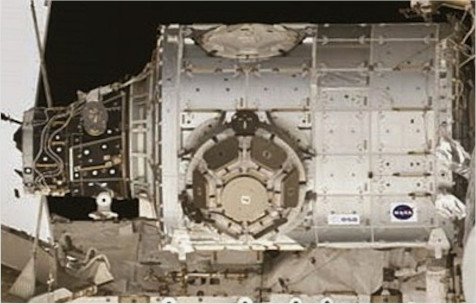
Nodes connect to many elements. Details are given in the sections below.
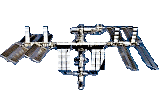

Nodes connect to many elements. Details are given in the sections below.

Nodes are used in the U.S./International Segment to connect main components together. Components in this segment were mostly transported to the station in the U.S. Space Shuttle. The size of components was therefore limited by the capacity of the shuttle's cargo bay.
Nodes allow the station to be enlarged by connecting additional components to the the core.
References: NASA: Unity, Harmony, Tranquility Wikipedia: Unity, Harmony, Tranquility ISA: Harmony
Nodes are pressurized cylinders with six ports; one at each end and four radial. When a node is connected to the station the radial ports face up, down and to the sides. Each port is fitted with an air tight door to seal the port when not in use or in an emergency.
All ports are fitted with a standardized fitting called a "Common Berthing Mechanism" (CBM). Any component fitted with a CBM can therefore be connected, or "berthed" to the node. A special case is the "Pressurized Mating Adapter" (PMA) used to dock the U.S. Space Shuttle to the station.
There are currently three nodes installed on the ISS. Each node has the same diameter and nodes 2 and 3 have the same length. Node 1. is 1.2 meters shorter.
Node 1. (Unity) ▼ - The first U.S. component placed onto orbit. Unity was delivered to the station on mission 2A by the U.S. Space Shuttle STS-88 (Endeavour) with PMA-1 and 2 berthed to each end. The three components, with PMA-1 aft, were then docked to the forward axial port of the FGB (Zarya) using the Shuttle's robot arm.
Node 2. (Harmony) ▼ - The second U.S. Node added to the station. Harmony was delivered to the station on mission 10A by the U.S. Space Shuttle STS-120 (Discovery) and berthed to the forward axial port of the U.S. Laboratory after Pressurised Mating Adaptor 2 [PMA-2] was temporarily relocated. PMA-2 was then berthed to the forward axial port of Harmony.
Node 3. (Tranquility) ▼ - The third U.S. Node added to the station. Tranquility was delivered to the station on mission 20A by the U.S. Space Shuttle STS-130 (Endeavour) and berthed to the port side port of Node 1 (Unity). Tranquility supports the Permanent Multi Purpose Module [PMM] and the Observation Cupola.
A detailed description of each node is given below.
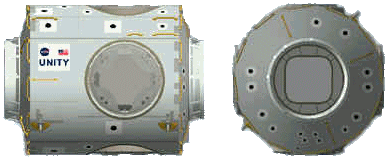
Node 1 (Unity) is installed along the main axis of the station in front of the Russian FGB (Zarya).
Unity has six berthing ports; one at each end and four around the circumference facing top, bottom, right and left.
Unity's ports are currently used as follows:-
1. Aft end - Pressurised Mating Adaptor One (PMA-1).
2. Forward end - U.S. Laboratory (Destiny).
3. Zenith (top) - Z1 Truss Structure.
4. Nadir (bottom) - Unused.
5. Starboard (right) - U.S. Joint Airlock (Quest).
6. Port (left) - Node 3 (Tranquility).
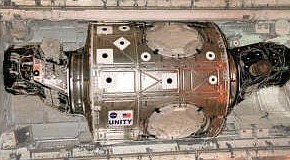
Unity was the primary cargo of the U.S. Space Shuttle Endeavour on mission STS-88 [Flight 2A], launched December 4, 1998.
Unity was transported to the station with Pressurised Mating Adapters 1 and 2 [PMAs] already mated to its end berthing ports.
This was the first shuttle mission dedicated to the assembly of the Station.
Unity was mated to the orbiting Zarya Control Module, via PMA-1, by the shuttle's crew.
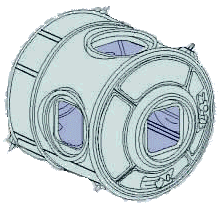
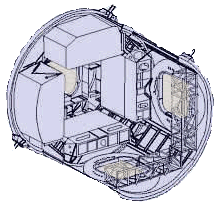
Unity was built for NASA by The U.S. Boeing Company at the Marshall Space Flight Center in Huntsville, Alabama.
Length: 5.5 m (18 ft)
Diameter: 4.3 m (14 ft)
Mass: 11,895 kg (26,225 lb)
Equipment Racks: 4
Fabrication: Aluminum
Mechanical items: 50,000
Fluids and Gas Lines: 216
Electrical cables: 121
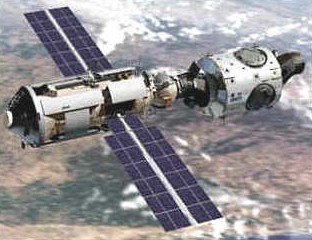
Node 2. (Harmony) is the second utility hub for the Station, providing air, electrical power, water and other systems for life support. Harmony is similar in shape to the Node 1. (Unity) but is longer than Unity and accommodates eight equipment racks, while Unity only accommodates four.
When Harmony was installed on the Station it was fitted with four Avionics racks, two Resupply Stowage racks and two Zero-g Stowage racks.
Harmony also acts as an internal connecting port and passageway and increases the living and working space inside the Station by more than 2,500 cubic feet. Harmony's exterior serves as a work platform for the Station's robotic arm, Canadarm2. Harmony is attached to the forward berthing port of the U.S. Laboratory (Destiny).
Harmony has six berthing ports; one at each end and four around the circumference facing top, bottom, right and left.
Harmony's berthing ports are currently used as follows:-
1. Aft end - Forward berthing port of the U.S. Laboratory (Destiny).
2. Forward end - Pressurised Mating Adaptor 2 (PMA-2).
3. Zenith (top) - Unused.
4. Nadir (bottom) - Unused.
5. Starboard (right) - ESA Laboratory Module (Columbus).
6. Port (left) - Japanese Experiment Module [JEM] (Kibo).
Harmony was designed and built for NASA by Thales Alenia Space in Torino, Italy, as part of an agreement between NASA and the European Space Agency.
The Boeing Company provided a large number of Harmony's sub-system components, including lights, fans, power switches and converters, racks, air diffusers, smoke detectors, hatches and Common Berthing Mechanisms. The node's subsystems were tested by Thales Alenia to ensure they operated within specifications common to all station elements.
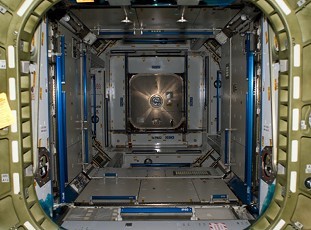
Boeing also built, installed onto Harmony, and tested five Active Common Berthing Mechanisms (ACBMs). The mechanisms enable on-orbit mating and airtight seals between ISS pressurized elements. The ACBMs consist of powered, computer-controlled components that align capture and are secured to the passive CBMs.
The CBM system is used throughout the Station to mate arriving pressurized elements to the existing modules. The system is comprised of two mating structures: the active half on the ISS and the passive half used on arriving structures.
While the active CBM contains all of the powered components and associated alignment hardware for berthing, the passive CBM configurations include the reciprocal mating fittings and alignment components, inclusive of the atmospheric seal. In a precisely controlled sequence of events, the ISS remote manipulation system positions the mating module passive CBM near the ISS active CBM for the automated berthing, resulting in a structurally sealed assembly.
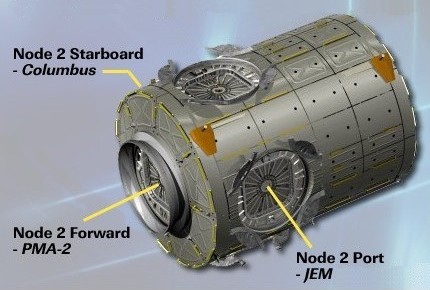
Harmony's general specifications are:-
Length: 6706 mm
Diameter: 4480 mm
Volume: 70 m3 (Pressurized)
Mass:
- Launch 14 500 kg
- Pay load 15 300 kg (On orbit)
Equipment Racks:
- Avionics Racks 4
- Re-supply Stowage Racks (RSR) 2
- Zero-g Stowage Racks 2
Harmony was delivered to the Station in October 2007 by Shuttle Discovery STS-120 [Flight 10A]. Harmony's installation was a two step process:
Step 1.
a. Discovery docks to pressurized mating adapter 2 (PMA-2), located on the forward end of Destiny.
b. Robot arms attach Harmony to a temporary position on the port side berthing port of Unity.
c. PMA-2 is out fitted with a Pressurized Common Berthing Mechanism.
d. Discovery un-docks from the Station and returns to Earth.
Step 2.
a. PMA-2 is moved from Destiny to the forward port (active CMB) of Harmony.
b. Harmony is moved from its temporary position to the forward end of Destiny.
Harmony, via PMA-2, then provided a docking port for the Space Shuttle, the Japanese HII transfer vehicle and as an attachment point for the Multi-Purpose Logistics Modules (MPLM).
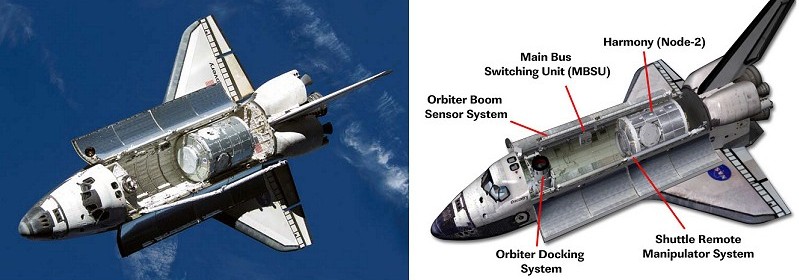
Node 3. (Tranquility) is the third utility hub for the Station, providing air revitalization, oxygen generation, carbon dioxide removal and water recovery systems. It also contains the bathroom for the crew hygiene and exercising equipment such as a treadmill and a weight-lifting device.
Tranquility has six berthing ports; one at each end and four around the circumference facing top, bottom, right and left.
Tranquility was delivered to the station in February 2010 by Shuttle Endeavour STS-130 [Flight 20A] and installed at right angles to the main axis of the station on the port side (left) of Node 1. (Unity).
The Cupola was also delivered on this mission, attached to the end cap port. It was then moved to Tranquility's nadir (bottom) port.
Tranquility's berthing ports are currently used as follows:-
1. Starboard end cap (right) - Node 1. (Unity).
2. Port end cap (left) - Pressurised Mating Adaptor 3 (PMA-3).
3. Zenith (top) - Parking location for the Special Purpose Dextrous Manipulator (SPDM).
4. Nadir (bottom) - Cupola.
5. Rear facing - Bigelow Expandable Activity Module [BEAM].
6. Forward facing - Permanent Multi Purpose Module [PMM] (Leonardo).
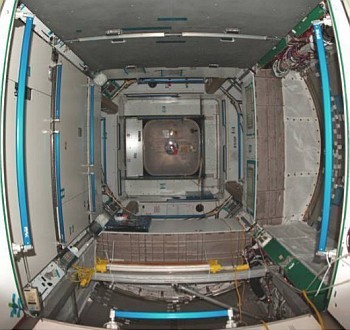
Tranquility was designed and built for NASA by Thales Alenia Space in Torino, Italy, as part of an agreement between NASA and the European Space Agency.
Tranquility is the same size and shape to the Node 2. (Harmony) and is also fitted with eight equipment racks. It is also will be out fitted with the Advanced Resistive Exercise Device for crew in-orbit physical exercise. Tranquility also acts as an internal connecting port and passageway and increases the living and working space inside the station.
Tranquility's pressurized shell of is constructed from aluminium alloys. This is covered with a multi-layer insulation blanket of Kevlar and Nextel for thermal stability and aluminium alloy panelling to act as a protective shield against space debris.
Internal and external secondary structures are used to support the installation of equipment, piping and electrical harnesses.
The atmosphere of Tranquility's internal pressurized volume is controlled in terms of air pressure, temperature, humidity, velocity, particulate and microbial concentrations.
There is also a piping network for the distribution of water (for fuel cells, drinking, waste and processes) between Node 1. and Node 3. and within Node 3. Pre-treated urine is transferred from the Waste and Hygiene Compartment to Water Recovery System racks inside Node 3. Special lines and sectioning devices are adapted to distribute oxygen and nitrogen.
Fire detection is supported by two cabin smoke sensors and monitoring of electrical equipment. Other smoke sensors are used in particular racks. Fire suppression within internal enclosures is by portable fire extinguisher.
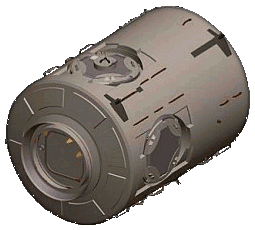
Tranquility's general specifications are as follows:-
Length: 6706 mm
Diameter: 4480 mm
Volume: 70 m3 (Pressurized)
Mass: 17,992 kg
Equipment Racks:
- Avionics (2)
- Air Revitalization (1)Monitoring and CO2 removal.
- Oxygen Generation (1) Producing oxygen from water.
- Water Recovery (2) Urine and water processing.
- Waste and Hygiene (1) Crew waste and hygiene.
- Treadmill (1)
